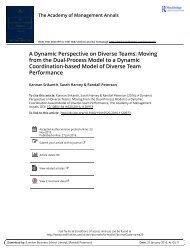The Process of Team Boundary Spanning in Multi-Organizational Contexts - Sarah Harvey, Randall S. Peterson, and N. Anand
Work teams must increasingly operate in complex environments characterized by multiple external actors beyond team and organizational boundaries. Although previous research demonstrates the importance of boundary spanning activities to team effectiveness, it reveals relatively little about the process of boundary spanning in these environments. In this article, we investigated the processes of boundary spanning across multiple external actors in 10 cross-organizational teams. We identified three sequences for reaching out to external actors: (a) moving inside-out from vertical actors inside the host organization to horizontal actors outside of the host organization, (b) moving outside-in from horizontal actors to vertical, and (c) staying-inside with vertical actors from the host organization. Our observations suggest that inside-out and outside-in sequences were more successful than simply pleasing the host organization. We build on our empirical findings to develop a process theory of how team boundary spanning activities across multiple external actors influence team effectiveness. Our research underscores the importance of a team’s interactions with actors in its external environment beyond those in an immediate supervisory role and provides insight into the dynamics of boundary spanning in multi-organizational contexts.
Work teams must increasingly operate in complex environments
characterized by multiple external actors beyond team and organizational
boundaries. Although previous research demonstrates the importance of
boundary spanning activities to team effectiveness, it reveals relatively little
about the process of boundary spanning in these environments. In this article,
we investigated the processes of boundary spanning across multiple external
actors in 10 cross-organizational teams. We identified three sequences for
reaching out to external actors: (a) moving inside-out from vertical actors inside
the host organization to horizontal actors outside of the host organization,
(b) moving outside-in from horizontal actors to vertical, and (c) staying-inside
with vertical actors from the host organization. Our observations suggest
that inside-out and outside-in sequences were more successful than simply
pleasing the host organization. We build on our empirical findings to develop
a process theory of how team boundary spanning activities across multiple
external actors influence team effectiveness. Our research underscores the
importance of a team’s interactions with actors in its external environment beyond those in an immediate supervisory role and provides insight into the
dynamics of boundary spanning in multi-organizational contexts.
You also want an ePaper? Increase the reach of your titles
YUMPU automatically turns print PDFs into web optimized ePapers that Google loves.
<strong>Harvey</strong> et al. 533<br />
Declaration <strong>of</strong> Conflict<strong>in</strong>g Interests<br />
<strong>The</strong> author(s) declared no potential conflicts <strong>of</strong> <strong>in</strong>terest with respect to the research,<br />
authorship, <strong>and</strong>/or publication <strong>of</strong> this article.<br />
Fund<strong>in</strong>g<br />
<strong>The</strong> author(s) received no f<strong>in</strong>ancial support for the research, authorship, <strong>and</strong>/or publication<br />
<strong>of</strong> this article.<br />
Note<br />
1. This def<strong>in</strong>ition <strong>in</strong>corporates task performance, <strong>in</strong> that teams who perform tasks<br />
well should be recognized as effective. However, the def<strong>in</strong>ition also <strong>in</strong>corporates<br />
other factors that may enable a team to be judged as effective, such as the visibility<br />
<strong>of</strong> the team’s performance.<br />
References<br />
Abbott, A. (1990). A primer on sequence methods. Organization Science, 1, 375-392.<br />
doi:10.1287/orsc.1.4.375<br />
An<strong>and</strong>, N., & Daft, R. L. (2007). What is the right organization design? <strong>Organizational</strong><br />
Dynamics, 36, 329-344. doi:10.1016/j.orgdyn.2007.06.001<br />
An<strong>and</strong>, N., Gardner, H. K., & Morris, T. (2007). Knowledge-based <strong>in</strong>novation:<br />
Emergence <strong>and</strong> embedd<strong>in</strong>g <strong>of</strong> new practice areas <strong>in</strong> management consult<strong>in</strong>g<br />
firms. Academy <strong>of</strong> Management Journal, 50, 406-428. doi:10.5465/<br />
AMJ.2007.24634457<br />
Ancona, D. G. (1990). Outward bound: Strategies for team survival <strong>in</strong> an organization.<br />
Academy <strong>of</strong> Management Journal, 33, 334-365. doi:10.2307/256328<br />
Ancona, D. G., & Bresman, H. (2007). X-<strong>Team</strong>s: How to build teams that lead, <strong>in</strong>novate,<br />
<strong>and</strong> succeed. Boston, MA: Harvard Bus<strong>in</strong>ess School Press.<br />
Ancona, D. G., & Caldwell, D. F. (1992). Demography <strong>and</strong> design: Predictors <strong>of</strong><br />
new product team performance. Organization Science, 3, 321-341. doi:10.1287/<br />
orsc.3.3.321<br />
Ancona, D. G., & Waller, M. J. (2007). <strong>The</strong> dance <strong>of</strong> entra<strong>in</strong>ment: Temporally navigat<strong>in</strong>g<br />
across multiple pacers. In R. Hodson & B. Rub<strong>in</strong> (Eds.), Research <strong>in</strong> the sociology<br />
<strong>of</strong> work (Vol. 17, pp. 115-146). Amsterdam, Netherl<strong>and</strong>s: JAI, Elsevier Press.<br />
Arndt, M., & Bigelow, B. (2000). Present<strong>in</strong>g structural <strong>in</strong>novation <strong>in</strong> an <strong>in</strong>stitutional<br />
environment: Hospitals’ use <strong>of</strong> impression management. Adm<strong>in</strong>istrative Science<br />
Quarterly, 45, 494-522. doi:10.2307/2667107<br />
Arrow, H., Poole, M. S., Henry, K. B., Wheelan, S., & Morel<strong>and</strong>, R. (2004). Time,<br />
change, <strong>and</strong> development: <strong>The</strong> temporal perspective on groups. Small Group<br />
Research, 35, 73-105. doi:10.1177/1046496403259757<br />
Balogun, J., Gleadle, P., Hailey, V., & Willmott, H. (2005). Manag<strong>in</strong>g change across<br />
boundaries: <strong>Boundary</strong>-shak<strong>in</strong>g practices. British Journal <strong>of</strong> Management, 16,<br />
261-278. doi:10.1111/j.1467-8551.2005.00463.x<br />
Downloaded from sgr.sagepub.com at London Bus<strong>in</strong>ess School Library on September 24, 2014
















